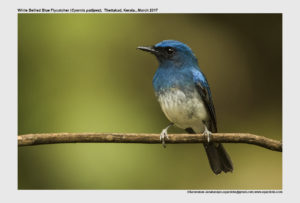
White-bellied Blue Flycatcher Cyronis pallipes
Etymology:
- Cyornis : Greek Word kuanos dark-blue; ornis
- Pallipes : Latin word pallidus –pale; pes – { Pale footed}
Vernacular Names: Mal: Kattuneeli, Mar: Pandharya potachi nili mashimar
Distribution in India: Resident of Western Ghats and Hills of West Tamil Nadu.
Description:Size of 14-15 cm; wt. of 14–23 g. It is a medium-sized and fairly long-billed forest flycatcher. The male is almost entirely indigo-blue, but with paler blue band across forehead to over eye, black face and chin, black flight-feathers, and white belly to undertail-coverts; iris dark; bill black; legs pinkish-flesh to grey. Female has grey head and face except for pale cream lower forehead, chin and lores to eye, olive-brown upperparts and upperwing, slightly darker flight-feathers, tail bright rufous or chestnut, throat to center of breast bright reddish-orange, sides buffish or brownish-buff, rest of underparts white. When perched, it has distinctive habit of lifting and spreading its tail. The juvenile is similar to female, with brown wings and bluish tail in male or chestnut tail in female. It has dark brown head and upperparts are heavily flecked and spotted buffish or buffish-brown, tips of median and greater upperwing-coverts are also buffish, chin and throat are unstreaked pale buff, becoming more heavily barred or scaled dark brown on breast and fading on flanks; bluish upperparts of first-year male begin to show at early age.
Habitat: It is found in Dense broadleaf evergreen forest, sholas and patches of dense or tangled patches on hillsides. Found in foothills from 300 m to 1700 m.
Food Habits: It eats small invertebrates and ripe berries. It is usually solitary or in pairs in breeding season, and in mixed-species flocks in non-breeding season. It is sluggish or lethargic, spending long periods inactive; inconspicuous and easily overlooked. It forages in thick tangles and undergrowth, gleaning insects from among low foliage; also makes aerial pursuit of flying insects, and may drop to ground.
Breeding Habits: They breed in Feb- Sept in India. The nest is an untidy, cup-shaped structure of moss, fine plant fibers and lichens, placed on ledge or in hole in tree stump close to ground, or in depression on sloping bank.They lay a clutch of 4 eggs.